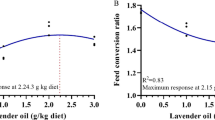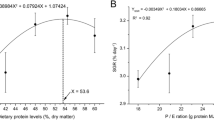Abstract
Female rainbow trout (Oncorhynchus mykiss) with an initial weight of 0.8–0.9 kg were raised in two experiments including a total of 2550 fish divided into 17 groups. The fish were raised for 6 months on 13 different feeds (four fish groups were replicates) varying in dietary levels of fat (27% or 32%), astaxanthin (40, 70 or 100 mg astaxanthin/kg feed) and vitamin E (α-tocopherol; 100, 300 or 600 mg all-rac-α-tocopheryl acetate/kg feed). The levels of fat, astaxanthin and α-tocopherol in the fillets all increased with increasing dietary levels of each feed component. Furthermore, astaxanthin deposition was found to be significantly improved by increasing the dietary fat level from 27% to 32%, but was not affected by dietary levels of α-tocopherol. The highest deposition of α-tocopherol was found in fish fed the lowest level of astaxanthin (40 mg/kg), whereas α-tocopherol deposition was unaffected by the dietary fat level. Frozen storage (–28 °C) of gutted, cleaned and glazed raw fish for 18 months significantly reduced astaxanthin and α-tocopherol levels, while lipid oxidation, measured as thiobarbituric acid reactive substances (TBARS) was limited. In the first experiment, the highest TBARS levels were found during frozen storage in fish fed the lowest level of astaxanthin (40 mg/kg versus 70 mg/kg or 100 mg/kg); unaffected by dietary levels of α-tocopherol (100 mg/kg versus 600 mg/kg), whereas the dietary astaxanthin level (70 mg/kg versus 100 mg/kg) did not influence lipid oxidation in frozen fish in the second experiment. After brine injection, fillets of fish were smoked and a vacuum-packed (95%), sliced product in a transparent laminate was produced. The quality (pigmentation and lipid oxidation) during 3 weeks of illuminated, chill storage (3 °C) was compared for smoked products produced from fresh fish and from fish stored at –28 °C for 12 months and 18 months. Smoked fillets from fish fed 32% fat were found to be less red than those from fish fed 27% fat, and the astaxanthin content and surface redness of the smoked product decreased during chill storage. Lipid oxidation was pronounced in smoked trout, but a high level of α-tocopherol in the fillet significantly reduced lipid oxidation during chill storage of the smoked product. Lipid oxidation in smoked fillets from fish fed 32% fat was more pronounced than in fish fed 27% fat, but increasing the dietary α-tocopherol level from 300 mg/kg feed to 600 mg/kg feed effectively counteracted the negative effect of the high-fat diet on lipid oxidation in the smoked product. Astaxanthin did not affect lipid oxidation in the chill-stored smoked product, in contrast to the frozen, raw fish. Astaxanthin seems to protect against the very early stages of lipid oxidation, while α-tocopherol is more important as an antioxidant at more advanced stages of lipid oxidation.
Similar content being viewed by others
Author information
Authors and Affiliations
Additional information
Received: 8 January 1998 / Revised version: 23 March 1998
Rights and permissions
About this article
Cite this article
Jensen, C., Birk, E., Jokumsen, A. et al. Effect of dietary levels of fat, α-tocopherol and astaxanthin on colour and lipid oxidation during storage of frozen rainbow trout (Oncorhynchus mykiss) and during chill storage of smoked trout. Z Lebensm Unters Forsch 207, 189–196 (1998). https://doi.org/10.1007/s002170050317
Issue Date:
DOI: https://doi.org/10.1007/s002170050317




